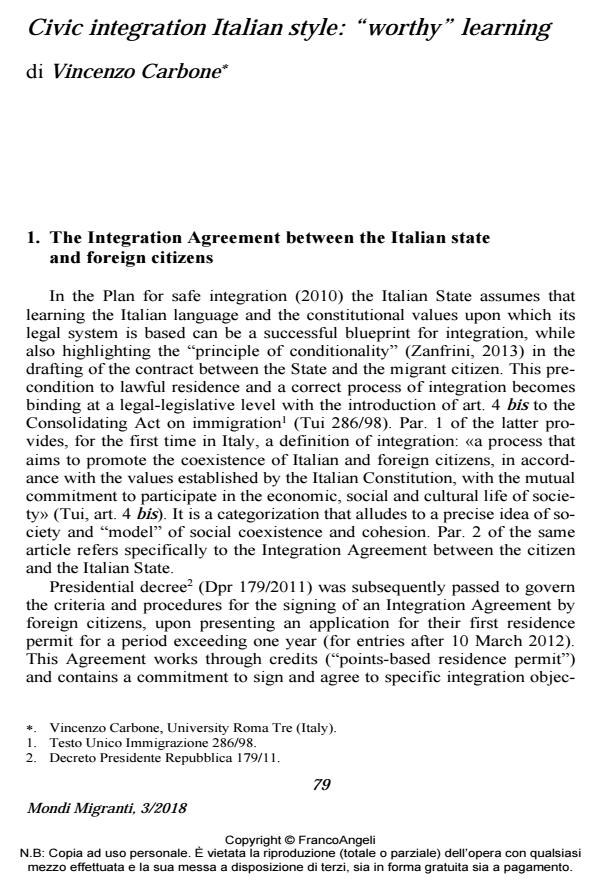Civic integration Italian style: "worthy" learning
Titolo Rivista MONDI MIGRANTI
Autori/Curatori Vincenzo Carbone
Anno di pubblicazione 2018 Fascicolo 2018/3
Lingua Italiano Numero pagine 15 P. 79-93 Dimensione file 201 KB
DOI 10.3280/MM2018-003005
Il DOI è il codice a barre della proprietà intellettuale: per saperne di più
clicca qui
Qui sotto puoi vedere in anteprima la prima pagina di questo articolo.
Se questo articolo ti interessa, lo puoi acquistare (e scaricare in formato pdf) seguendo le facili indicazioni per acquistare il download credit. Acquista Download Credits per scaricare questo Articolo in formato PDF

FrancoAngeli è membro della Publishers International Linking Association, Inc (PILA)associazione indipendente e non profit per facilitare (attraverso i servizi tecnologici implementati da CrossRef.org) l’accesso degli studiosi ai contenuti digitali nelle pubblicazioni professionali e scientifiche
This article focuses on the link between admission policies for non-EU citizens in Italy and models of integration, and explores, in particular, the distinctive characteristics of the Italian civic integration experience and the Integration Agreement, that was introduced to the country’s legal system with the "security package" in 2009 and implemented by presidential decree 179/2011. In particular, the article looks at the legislative and procedural developments of the Integration Agreement, highlighting the stratification over time of the legislative output and the changing political and communication environments. Starting from the Plan for safe integration in 2010, a policy paper that defined the Italian integration model, we shall focus on three issues: the governing of human mobility and the establishment of the model of civic integration; the multilevel governance of integration processes, with the allocation of territorial resources; the involvement of migrants in production that is "active" and "worthy" of social citizenship. The integration of non-EU foreign citizens, which is promoted and implemented by the Plan and by the Integration Agreement, alludes to a process of adaptive and compulsory learning, for the purpose of the subjugation of foreign citizens without any active participation on their part. A complex computational system (Register of adherents) measures credits and debits ("points-based residence permit"), thus evaluating foreign citizens’ adherence to the Italian ethical, civic and linguistic her-itage and the conformity of their social conduct. In this way, the stay in Italy and social inclusion of foreign citizens is governed and achieved through the oxymoron of a "unilateral contract" and as a "rewarding" device of social governance.
Parole chiave:Civic integration; accordo di integrazione; apprendimento civico e linguistico; multilevel governance dell’integrazione; cittadinanza; multiculturali-smo
- “Italians, first!” Unpacking the link between nationalism and immigrant discrimination Simona Guglielmi, in Quaderni di Sociologia /2021 pp.37
DOI: 10.4000/qds.4754
Vincenzo Carbone, Civic integration Italian style: "worthy" learning in "MONDI MIGRANTI" 3/2018, pp 79-93, DOI: 10.3280/MM2018-003005